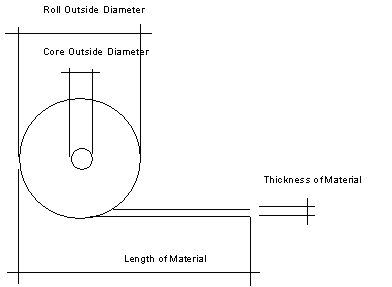Roll Diameter Calculator
This calculator can be the starting point of determining the size, weight and costs of converting materials that are provided in a roll format.
A roll diameter calculator is frequently used to determine the length of the converter material in an existing roll. But it can also be used to get material thickness of the converter material. Instead of manually using a complex formula to get your material estimate, you can quickly get an estimate of roll length or material thickness.
Top considerations using a roll diameter calculator
For estimation purposes only. A roll can be tightly or loosely wound. These factors will affect estimated length of your material, as well as the estimated thickness. Variations are extremely common and are difficult to account for. For that reason, the calculation of your roll diameter should be used for estimation purposes only.
When entering material thickness:
- Include the liner in the measurement.
- If there’s range of thickness in the material, use the highest number in the range to help you plan for the material costs.
When entering the outer roll diameter:
- Measure from the second to last full revolution of the material. This will account for possible damage near the core and hedge against material shortage.

How to use a roll diameter calculator
When using the roll diameter calculator, you’ll need to enter three of these four values:
- Material thickness in mils
- Length of roll material in feet
- Outer core diameter in inches
- Outer roll diameter in inches
For example, if you have measurements for these three fields:
- material thickness is 3.25 mils
- outer core diameter is 3.75 inches
- outer roll diameter is 16.25 inches
Then the calculator would provide a material length estimate of 5035.2564 feet.
The Roll Diameter Calculator
To get a successful estimate from our roll diameter calculator, here are some important aspects to keep in mind:
- Convert all fractions to decimals
- Convert inches to feet, and feet to inches as indicated in the fields
- Convert millimeters to mils
- There’s no need to enter unit labels in the fields
(i.e., “6.5 inches” is incorrect. “6.5” is correct.) - Note: Do not type units or fractions into the entry boxes. For example, enter 5.5 for inches, not 5.5″ or 5.5 in. Also, enter 3.0 Mils as simply 3.0, not .003.
- Since roll diameter is affected by how tight or loose a roll may be wound, these calculations should be used as estimates.
Fill in any three of the four values – the missing value will be calculated for you.